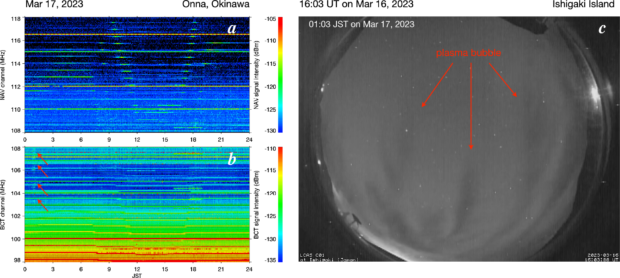- Recommended articles
- November 1, 2023
[Frontier Letter] Monitoring of equatorial plasma bubbles using aeronautical navigation system: a feasibility study

Equatorial Plasma Bubbles (EPBs) are regions of depleted plasma in the ionosphere that develop at low and equatorial latitudes. EPBs are known to affect the propagation of various trans-ionospheric radio waves and can occasionally lead to disruptions or degradation of satellite-based navigation systems such as the Global Positioning System (GPS). Therefore, routine monitoring of EPBs is crucial for the precise space weather prediction. Hosokawa et al. (2023) introduced a novel method for monitoring EPBs using passive observations of VHF radio waves commonly utilized for aircraft navigation. Their feasibility study suggests that this technique can detect the occurrence of EPBs over a wide area only by operating a small receiver at a single location. Currently, they are establishing a network (http://gwave.cei.uec.ac.jp/cgi-bin/vor/vhf_tst.cgi) of such passive radio measurements that covers extensive regions in the low-latitude and equatorial zones of the Asian longitudes, which will enhance our ability to monitor the space weather impact of EPBs on a routine basis.
- Hosokawa et al. (2023): Monitoring of equatorial plasma bubbles using aeronautical navigation system: a feasibility study. Earth Planets Space 75:152, https://doi.org/10.1186/s40623-023-01911-7.

![[Frontier Letter] COURSE: Cross-scale cOUpling pRocesses in the Solar–tErrestrial system—SCOSTEP’s new program for 2026–2030](https://www.earth-planets-space.org/wp-content/uploads/2025/12/fig1-80x26.png)
![[Frontier Letter] Double difference earthquake location with graph neural networks](https://www.earth-planets-space.org/wp-content/uploads/2025/08/40623_2025_2251_Figa_HTML-1-80x40.webp)
![[Frontier Letter] A new paleomagnetic constraint on the duration of a twin caldera-forming eruption sequence: a potential solution to an enduring problem in decoding >VEI 7 eruption timescales](https://www.earth-planets-space.org/wp-content/uploads/2025/05/40623_2025_2179_Figa_HTML-75x40.webp)

